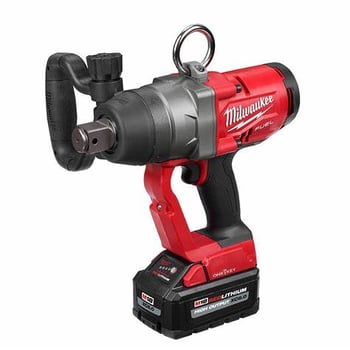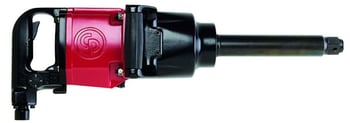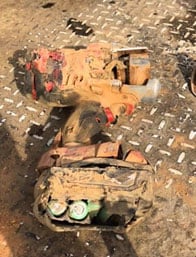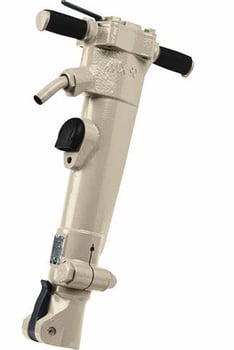Battery Powered vs. Pneumatic Tools: Which Are Better For Mobile Work?
 Are battery tools only for hobbyists, or do they have a place on the job site? Will battery electric tools eliminate the need for pneumatic tools? What tools are best for mobile workers? Read on to find out.
Are battery tools only for hobbyists, or do they have a place on the job site? Will battery electric tools eliminate the need for pneumatic tools? What tools are best for mobile workers? Read on to find out.
Until recently, mobile service operators favored pneumatic tools, partially because they were more powerful than electric alternatives. The largest battery powered electric impact wrenches were ½”, and anyone who needed tools with serious torque, such as a 1” impact wrench, would automatically default to pneumatic options.
But then Milwaukee released a battery powered 1” high torque impact wrench in 2019, and it was the first impact wrench to rival its pneumatic counterpart. The M18 1” high impact wrench produces 1500 ft-lb of fastening torque and 1800 ft-lb of nut breaking torque at a comparable cost. It also weighs half as much as the pneumatic alternatives, which makes it easier to lift.
Take a look at the weight of the Milwaukee impact wrench compared to some of its rival impact wrenches:
1” High Torque Impact Wrench Comparison
| Milwaukee M18 1” High Torque | Ingersoll Rand 285B |
Chicago Pneumatic CP7782 | |
| Power Source | Electric Battery |
Pneumatic | Pneumatic |
| Weight | 12.9 lb (with battery) |
24.6 lb | 22.2 lb |
| Fastening Torque | 1,500 ft-lb | 1,475 ft-lb | 1,480 ft-lb |
| Nut Breaking Torque | 1,800 ft-lb | 1,475 ft-lb | 1,920 ft-lb |
Why Pneumatic Tools Still Beat Battery Power Alternatives
 Milwaukee currently has the most powerful 1” battery powered impact wrench, and it might be making some pneumatic tool executives sweat, but it still has nothing on some of the pneumatic tools out there. If you need more than 1,800 ft-lb of nut breaking torque, you’re back into pneumatic territory where Chicago Pneumatic (CP) and Ingersoll Rand (IR), among others, have 1” impact options that easily exceed those capabilities:
Milwaukee currently has the most powerful 1” battery powered impact wrench, and it might be making some pneumatic tool executives sweat, but it still has nothing on some of the pneumatic tools out there. If you need more than 1,800 ft-lb of nut breaking torque, you’re back into pneumatic territory where Chicago Pneumatic (CP) and Ingersoll Rand (IR), among others, have 1” impact options that easily exceed those capabilities:
| CP796 | CP5000 | IR 2850MAX | |
| Fastening Torque | 1,400 ft-lb | 2,065 ft-lb | 2,000 ft-lb |
| Nut Breaking Torque | 2,000 ft-lb | 2,500 ft-lb | 2,100 ft-lb |
More Choice With Pneumatic
Pneumatic tools also make the most sense when you want options. While the M18 1” impact wrench may have been a market disrupter when it was released, there have not been any notable new battery tools released since. By contrast, pneumatic tool brands have been cranking out high torque options for decades, which means there’s a huge range in size, weight, cost, features, ergonomics, and styles to choose between. If you want options, pneumatic makes the most sense.
Pneumatic Tools Are Tried & True
 We’ll also have to see how durable battery powered tools can be over the long term. Electric battery powered tools have a reputation for being less hardy than pneumatic tools because they contain more moving parts, including an integrated motor. This makes them more susceptible to wear, tear, and operator abuse.
We’ll also have to see how durable battery powered tools can be over the long term. Electric battery powered tools have a reputation for being less hardy than pneumatic tools because they contain more moving parts, including an integrated motor. This makes them more susceptible to wear, tear, and operator abuse.
Being able to withstand the hardships of everyday work is a bare minimum requirement for any tool, and this is especially true on remote job sites, so only time will tell if electric models can truly replace pneumatic options.
Batteries & Other Power Sources
.jpg?width=350&height=262&name=OIP%20(2).jpg) Batteries are another crucial consideration because nothing stops work faster than dead batteries. Batteries on electric tools need to be recharged frequently and outlets aren’t always available on the road, which means mobile service operators need an inverter and bank of spare batteries on the truck.
Batteries are another crucial consideration because nothing stops work faster than dead batteries. Batteries on electric tools need to be recharged frequently and outlets aren’t always available on the road, which means mobile service operators need an inverter and bank of spare batteries on the truck.
As a result, operators must have and maintain two separate power sources on board: diesel or gas to fuel the vehicle, plus electricity. By contrast, the air compressors that power pneumatic tools typically tie into the engine or PTO, or use the existing fuel source. Air compressor systems only require the existing power sources, which makes pneumatic tools a more practical mobile solution.
Battery Powered Tools Other Than Impact Wrenches
 This article focuses on 1” impact wrenches because it’s one of the most popular tools out there. When we see brands like Milwaukee release bigger, better tools, we get a glimpse of where their R&D is focused and it’s a great indicator of where battery powered tool manufacturers are headed in the future.
This article focuses on 1” impact wrenches because it’s one of the most popular tools out there. When we see brands like Milwaukee release bigger, better tools, we get a glimpse of where their R&D is focused and it’s a great indicator of where battery powered tool manufacturers are headed in the future.
But what about other tools, right now? While we’re seeing small gains for medium sized electric tools, there’s little innovation on the larger tool front. Powerful tools need powerful power sources.
When it comes to pavement breakers and jackhammers, impact wrenches over 1”, and compression tools, it’s hard to beat the pneumatic options on the market. Battery tools may not ever be able to properly handle big jobs like track bolts, heavy equipment repair and OTR tire repair work.
Should You Work With Battery or Pneumatic Tools?
We’re an air compressor manufacturer so our bias is always towards air. It’s powerful, effective, and downright cool. But at the end of the day, the right answer to this question is going to vary by the individual and the work they do. Open the toolboxes on most service trucks, and you’ll see a mix of pneumatic, electric, and manual tools.
It’s possible more pneumatic tools will be replaced by electric alternatives in the future. But for now, air tools are still the winners when it comes to durability, power, and diverse options. That makes pneumatic tools the clear choice for mobile operators who want a single, straight-forward power source for all their tools.
